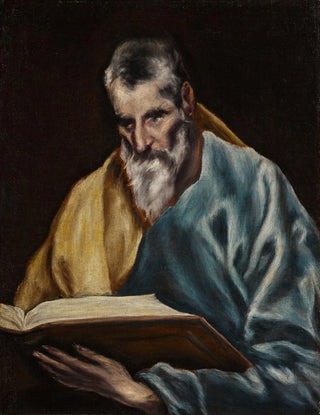Art print | Saint-Simon - El Greco


View from behind

Frame (optional)
Saint-Simon Art print - El Greco – Captivating Introduction
The "Saint-Simon" artwork by artist El Greco is a masterpiece that embodies the spiritual depth and emotional richness of 16th-century painting. In this piece, the artist manages to capture the very essence of the saint, both in his outward appearance and in his soul. The depiction of Saint-Simon, with his penetrating gaze and contemplative attitude, invites viewers to reflect on faith and devotion. This painting is not merely a religious illustration; it transforms into an open window to an era where art and spirituality were inextricably intertwined.
Style and uniqueness of the work
El Greco, whose real name is Domenikos Theotokopoulos, is renowned for his distinctive style that combines elements of Italian Renaissance with a more expressive and dramatic approach. In "Saint-Simon," vibrant colors and elongated forms are characteristic of his artistic approach. The rich palette, composed of deep blues and dazzling golds, gives the artwork a mystical atmosphere. The light, omnipresent, seems to emanate from the figure itself, emphasizing the spirituality radiating from the piece. The flowing drapery and meticulous details of the saint’s clothing demonstrate exceptional craftsmanship, while the dynamic composition guides the viewer’s eye through the work, creating an immersive visual experience.
The artist and his influence
El Greco is an iconic figure in art history, whose influence extends well beyond his era. Born in Crete, he established himself in Toledo, Spain, where he developed a style unique to him. His artistic vision marked the Mannerist movement and paved the way for generations of artists. The treatment of emotions and the omnipresent spirituality in his works have inspired masters such as Picasso and Soutine. "Saint-Simon" is a perfect example of his ability to transcend mere representation and touch the very essence of human existence. His capacity to fuse theology and art helped redefine the role of the artist as an intermediary between the divine

Matte finish

View from behind

Frame (optional)
Saint-Simon Art print - El Greco – Captivating Introduction
The "Saint-Simon" artwork by artist El Greco is a masterpiece that embodies the spiritual depth and emotional richness of 16th-century painting. In this piece, the artist manages to capture the very essence of the saint, both in his outward appearance and in his soul. The depiction of Saint-Simon, with his penetrating gaze and contemplative attitude, invites viewers to reflect on faith and devotion. This painting is not merely a religious illustration; it transforms into an open window to an era where art and spirituality were inextricably intertwined.
Style and uniqueness of the work
El Greco, whose real name is Domenikos Theotokopoulos, is renowned for his distinctive style that combines elements of Italian Renaissance with a more expressive and dramatic approach. In "Saint-Simon," vibrant colors and elongated forms are characteristic of his artistic approach. The rich palette, composed of deep blues and dazzling golds, gives the artwork a mystical atmosphere. The light, omnipresent, seems to emanate from the figure itself, emphasizing the spirituality radiating from the piece. The flowing drapery and meticulous details of the saint’s clothing demonstrate exceptional craftsmanship, while the dynamic composition guides the viewer’s eye through the work, creating an immersive visual experience.
The artist and his influence
El Greco is an iconic figure in art history, whose influence extends well beyond his era. Born in Crete, he established himself in Toledo, Spain, where he developed a style unique to him. His artistic vision marked the Mannerist movement and paved the way for generations of artists. The treatment of emotions and the omnipresent spirituality in his works have inspired masters such as Picasso and Soutine. "Saint-Simon" is a perfect example of his ability to transcend mere representation and touch the very essence of human existence. His capacity to fuse theology and art helped redefine the role of the artist as an intermediary between the divine






